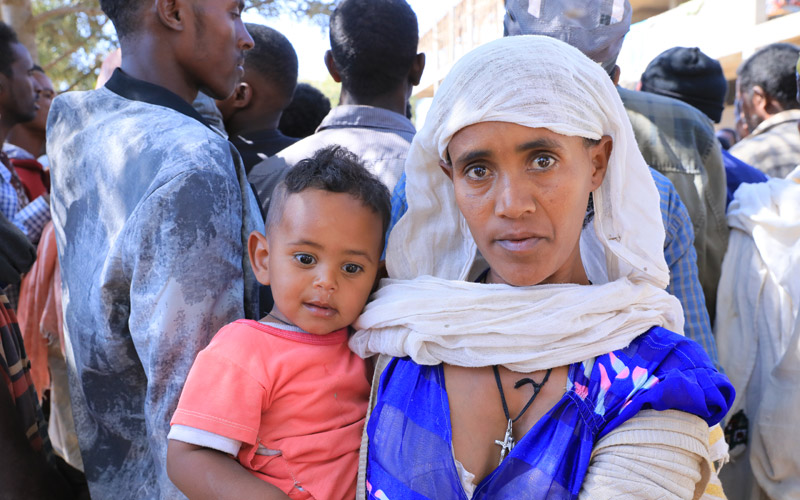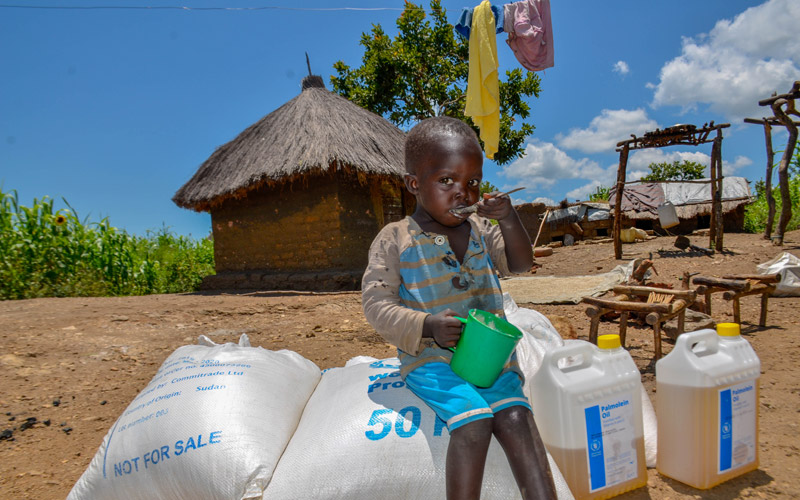Today, World Vision declared its highest level of emergency response to address a rapidly escalating
hunger crisis across East Africa. A deadly mix of COVID-19, conflict and
climate change has pushed more than seven million people across six countries to the very edge of starvation.
“
Malnutrition is spreading quickly, particularly among vulnerable children, and those forced from their homes,” says Lindsay Gladding, World Vision Canada’s Fragile & Humanitarian Response Director. “Without urgent action from Canadians and the international community to help meet food needs across the region, thousands of children could die.”
People living in the
Tigray region of Ethiopia have been amongst the hardest hit. Violent conflict has forced tens of thousands of children and their families to flee their homes. After nearly four months of fighting thousands of people have been killed and tens of thousands more have fled across the border into Sudan.
 Leges,30, a mother of six, fled conflict in the Western Tigray region, to a camp for internally displaced people. Photo: World Vision Ethiopia Staff
Leges,30, a mother of six, fled conflict in the Western Tigray region, to a camp for internally displaced people. Photo: World Vision Ethiopia Staff
“I rushed to flee, leaving behind all my property to save my children’s and my life,” says Leges, a mother of six living in a Tigray displacement camp. “I came here expecting at least to get food, water and shelter. Unfortunately, I am getting little or no food.”
Even before the conflict, over one million people in Tigray were reliant on humanitarian assistance and more than 600,000 were grappling with hunger while doing everything in their power to get through each day.
Millions of people like Leges and her children have now been cut off from food assistance in the region.
Help fight hunger
The global pandemic is proving to be a tipping point for children and families already grappling with conflict, flooding, drought and
desert locust infestations. These vulnerable communities are now at the greatest risk of
famine, pushed towards the edge of survival by
COVID-19’s economic shocks and instability that continues to destroy livelihoods, sinking millions of people into deeper poverty and hunger.
According to UN reports and World Vision data, 108,000 people in East Africa are now living under the most urgent, catastrophic famine-conditions, marked by critical acute malnutrition, starvation, destitution, and death. Another seven million people are just one step away from famine and 26 million more are on the verge of needing emergency food assistance.
 “Jemima”, a child refugee from South Sudan eating porridge provided by World Vision through the World Food Program in the Bidibidi refugee settlement in Uganda. Food rations in the camp have been cut because of declining funds. Photo: Brian Jakisa
“Jemima”, a child refugee from South Sudan eating porridge provided by World Vision through the World Food Program in the Bidibidi refugee settlement in Uganda. Food rations in the camp have been cut because of declining funds. Photo: Brian Jakisa
“Rising
food insecurity also dramatically increases the risks faced by women and girls, including gender-based violence and sexual exploitation and abuse,” says Gladding. “In the face of unprecedented global demands for humanitarian funding, crises in East Africa are receiving limited international attention, despite these urgent and life-threatening needs.”
Due to the growing crisis, World Vision has declared an emergency response for Ethiopia, Kenya, Somalia, South Sudan, Sudan and Uganda to avert the looming risk of famine. World Vision intends to reach 2.4 million people, including 490,000 children across the affected countries to mitigate the impact of the crisis.
East Africa is not alone in its hunger crisis warning. Approximately 30 million people are at emergency hunger levels across 36 countries globally.
Here's how you can help fight crises like this one -
Act Now!